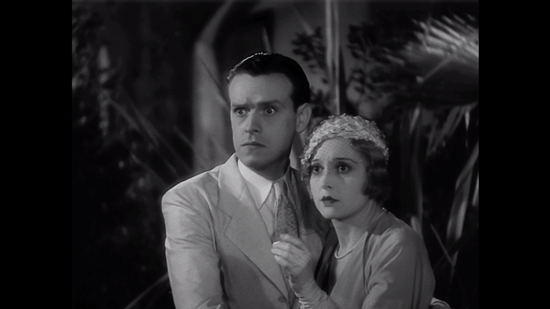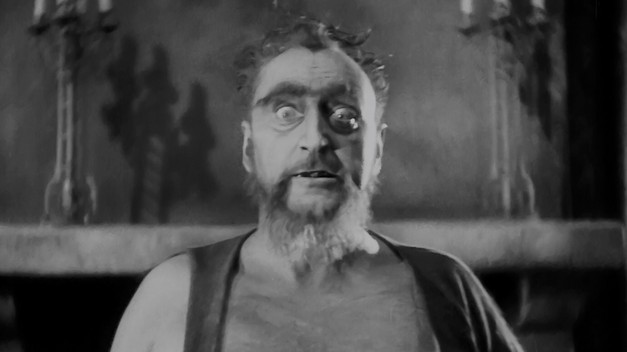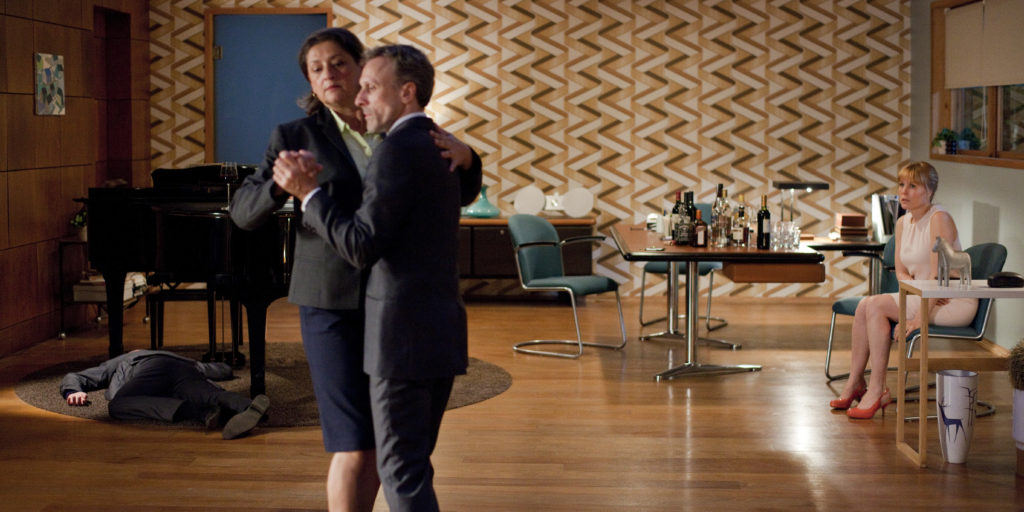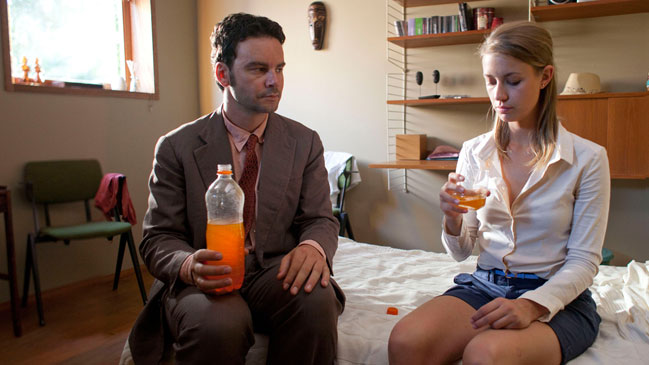Bela Lugosi and friend in tourism campaign for Haiti.
This January, in support of the Toronto Rape Crisis Centre / Multicultural Women Against Rape, friends and family have raised over $1,000, which means I have to watch and write about thirty-one horror movies. I’ll watch (on average) one movie a night, many of them requested by donors, after which I’ll write some things about said movies on this website. Be forewarned that all such write-ups will contain spoilers! Today’s film is a classic, White Zombie, directed by Victor Halperin and starring the Clark Gable of horror movies, Bela Lugosi. One of my oldest friends, Callie Callon – the person who introduced me to The Smiths and The Rocky Horror Picture Show – donated to the fundraiser and requested “something with zombies.” So I selected one of the first films ever to feature a zombie, though you may better know this film for giving Rob Zombie’s band their name. White Zombie is actually in the public domain, so I watched it right there on YouTube.
What happens:
A pre-Code (though you’d hardly know it) horror film with a title familiar to any 90′s kids who grew up singing “More Human than Human,” White Zombie was an independently produced horror film that is generally credited as being the first feature-length zombie movie. The movie opens with Haitian natives chanting behind a Zulu-style title sequence, so buckle up, readers! We’re in for a culturally insensitive ride! A young couple in a stagecoach, Neil Parker (John Harron) and Madeleine Short (Madge Bellamy), come across some sort of tribal rite happening in the middle of the road. They ask their driver what’s happening, and he informs them it’s a funeral. To prevent grave-robbers, they’re burying this body in the middle of the road, where there are many passersby. Smart! But Neil can’t see the wisdom in it and sarcastically remarks, “That’s a cheerful introduction for you to the West Indies!” Then glowing eyes superimposed over the scene hint that things are about to get even less cheerful.
Neil and Madeleine are in Haiti to be married, and the coach is taking them to the spot where the wedding will take place, the Beaumont Plantation. Continuing their ride, the driver pulls over to ask directions from a man with an elaborate beard who is dressed kind of like Shang Tsung from Mortal Kombat. The bearded man just stares at Madeleine with hypnotic eyes. Soon some strange people lumber down the hill behind him. “Zombies!” the driver exclaims and they ride away in haste, leaving Madeleine’s scarf in Shang Tsung’s hands. Future husband Neil is confused by the rough ride, but the driver explains he didn’t want to be caught by zombies, who he describes as living corpses forced to work in sugar mills.
They eventually find their way to the Beaumont Plantation, where they meet a white missionary, Dr. Bruner (Joseph Cawthorn), who reassures the nice white couple that they shouldn’t be spooked by zombies: Haiti is full of superstitions. The doctor asks how they know Charles Beaumont (Robert Frazer), the wealthy plantation owner (is there any other kind?). The couple mention they met him on the boat to Haiti. Bruner is a bit confused by Beaumont’s interest in them. Already suspecting something untoward, he advises they clear out of the house as soon as they’re married and stay away from Beaumont. Upstairs, having been informed by his butler, Silver that “the young people have arrived,” Beaumont, who looks like Dan Marino and Oscar Wilde’s lovechild, hesitates but decides to greet them. Silver also cryptically tells him he shouldn’t wait on “that other person,” but Beaumont pooh-poohs him. “I must have her,” he insists.

All this zombie business is really putting a damper on Neil and Madeleine’s wedding.
Beaumont greets Bruner and the young couple, and Neil immediately suspects Beaumont’s motives of being less than squeaky-clean. After showing them to their rooms, Beaumont absconds into the night on a carriage with a blind man who looks more or less like the personification of death. Neil witnesses their exit from his bedroom window. Beaumont and Death travel to a sugar mill entirely powered by zombie labour. As you might imagine, workplace safety is not a priority: one of the zombies falls into a sugar thresher (is that a thing?) and soundlessly dies (again, I guess). The only non-zombie working at the mill is that bearded man we saw earlier, “Murder” Legendre (Bela Lugosi) – yes, that’s his name – who controls the zombies. “They’re not worried about long hours,” he laughs. Beaumont has come to Legendre to undertake some skullduggery that will win the fair Madeleine’s heart. Legendre totally understands Beaumont’s obsession. After all, he’s seen Madeleine and has become quite fond of her scarf.
At first, Beaumont plots to make the fiancé, Neil, disappear, but Legendre, in his Eastern European accent, dissuades him: he’s dubious Beaumont would be able to successfully woo Madeleine after her her boyfriend disappeared. Besides, he’s gazed into her eyes; he can spot a woman fully in love. “She’s to be married in an hour,” Beaumont laments. “There must be a way.” Legendre informs him there is a way, but he’s not going to like the cost. Beaumont promises he’ll give Legendre anything if he tells him how to have Madeleine. Legendre leans over and whispers in his ear, and Beaumont balks. “No. Not that!” It’s a very Meat Loaf moment.
Legendre gives him a vial of powder and tells him to use just a pinch, then call for him once he’s used it. On another part of the island, Madeleine is preparing for the big day in her room. Tribal drums can be heard out the window, and the chambermaids inform her the drummers are warding off evil spirits. (They must be playing the wrong tempo; someone should get J.K. Simmons on the case.) Beaumont then walks Madeleine down the aisle, literally pleading with her to leave Neil as he does. Madeleine follows her heart and marries Neil, but it turns out to be a very short honeymoon. During the wedding dinner, Madeleine sees a vision of Murder Legendre in her wine goblet. The real Legendre is stalking the plantation grounds outside with a voodoo doll he’s made from Madeleine’s scarf. He holds the doll over the flame of a lantern and Madeleine passes out at the dinner table.
Well, not just passes out. She straight-up dies. In the following scene, some Haitian locals are placing Madeleine’s casket in a tomb. Neil promptly drinks his sorrows away in a Haitian gin mill, all the while haunted by Madeleine’s ghost. He sees visions of Madeleine everywhere, staggering out of the bar as he chases her ghost. Elsewhere, Beaumont and Legendre make a midnight rendezvous in the cemetery to retrieve the dead bride. At this point, Legendre informs Beaumont he learned his supernatural secrets from the Haitian witch doctor. He commands his zombie minions to retrieve the coffin containing Madeleine, as she’s not really dead. The powder merely put her into a temporary catatonic state, a la Romeo and Juliet. (Shakespearean spoiler alert!)
Improbably, Neil has drunkenly stumbled into the cemetery, shouting loudly and interrupting Legendre’s unseemly work. The zombies and their sinister master flee, leaving Neil to discover Madeleine’s empty tomb. He screams bloody murder. In his office later, Dr. Bruner talks some sense into Neil: “Either the body has been stolen by a death cult, or else … she’s not dead.” Totally logical. Neil doesn’t like either option, but Dr. Bruner notes that behind every Haitian superstition is some truth. He whips out a law book (a beacon of reason if ever there was one) and notes that the Haitian legal system even has laws forbidding use of drugs to put people into a comatose state. (It’s attempted murder in Haiti.) The powers of voodoo are well known. Neil immediately blames Beaumont, who he knows had designs on Madeleine, but Bruner is certain he sees the handiwork of a Haitian witch doctor. Neil wants to summon the police, but Dr. Bruner has a better idea: to round up a posse of some of his native Haitian friends. (Dr. Bruner is one of those “some-of-my-best-friends-are-Haitian” guys.)

Murder Legendre toasts your lack of future with his tiny glass.
The film cuts to a seaside castle keep high upon a mountain. Inside Beaumont sits in a parlour as the now awake Madeleine listlessly plays a song on the piano. Madeleine, whose eyes are so large, she’s basically a Precious Moments illustration, has lost all the verve she once had. Legendre has put her in a zombie trance and, as Beaumont says, all the life has gone from her eyes and her smile is gone. (Who’d have thought putting the woman you like in a zombie trance wouldn’t work out as well as you’d hoped?) Beaumont is ready to throw in the towel, to return Madeleine to the grave. Legendre, arriving in his parlour in his fine formal wear, is disheartened to hear this. He has brought a gang of zombies with them, all looking like slightly more dishevelled Trivago guys. He pours some wine for Beaumont and himself and they toast to the future, but from Legendre’s smile, viewers realize Beaumont doesn’t have much of a future left. Legendre has drugged Beaumont’s wine, and he’ll soon be a zombie, too.
Beaumont hollers for his butler, Silver, but Legendre hypnotizes the older man with his powerful eyes, and a few of the grim zombies haul Silver away. Silver is tossed into the sea and Beaumont is left helpless with a voodoo madman. Meanwhile, Neil and Dr. Bruner, making their trek to Legendre’s castle, are abandoned by Bruner’s Haitian friends. One of them, Pierre, says they won’t accompany them to the mountain, which they call “The House of the Living Dead.” A cloud of vultures – the loudest creatures in the world, according to this film – hovers over the castle as a warning, but Burner and Neil continue on. Neil has a bit of a manic episode, worrying about Madeleine and Bruner leaves him to ascend the mountain alone. Upon that mountain top, Legendre’s chambermaids appear to be preparing Madeleine for a second wedding. Beaumont rocks in his seat in the parlour, now clearly under Legendre’s zombie control.
Neil rouses himself and heads to the castle. But after a long climb he passes out with exhaustion on a chaise-lounge on the second landing of the castle’s very large parlour. Legendre, having seen Neil enter, stares hard and presses his hands together – an action that impels Madeleine to go after her husband with a knife. But as she brings up the blade, she struggles with the zombie trance. Eventually, a hand pops out from the doorway (probably Bruner) and takes the knife from her. Madeleine, in her confusion, rushes past the increasingly agitated Legendre and toward the rocky cliffside.
In the middle of all this commotion, Neil wakes and runs to Madeleine, grabbing her just before she dashes herself on the rocks below. Neil shouts with joy but finds his wife strangely unresponsive, due to the zombie trance and all. (“My darling, what have they done to you?”) Legendre summons his zombies and sets them upon Neil. Neil didn’t come empty-handed, though, and shows the zombie thugs the business end of his revolver. But it has no effect! How can he kill what is already dead? Just when it looks like Neil’s seen his last Haitian sunset, Dr. Bruner sneaks up behind Legendre and knocks him out with a blackjack.
While he’s unconscious, Legendre’s control over his zombies breaks. The directionless zombies walk off the cliff, lemming-style, and Madeleine begins to regain consciousness. She starts to recognize Neil, but before long, Legendre is back on his feet. Madeleine again is under his spell, and Legendre begins to make his escape under the cover of smoke bombs. He starts to hypnotize Madeleine again, when who should show up and save the day but creepy Charles Beaumont. Beaumont lurches up behind Legendre and tosses him off the cliff and to his doom. In the exertion, Beaumont too falls to his untimely end. With only lovers left alive (and Dr. Bruner), the young couple reunite with a kiss.

Just think of this guy whenever you add sugar to your coffee.
Takeaway points:
- White Zombie could have had the alternate title Male Entitlement. It’s fairly obvious to give White Zombie a feminist reading (as it is with many horror movies), but that doesn’t make it any less valid. White Zombie is the story of what happens when one man (Beaumont) gets friendzoned and can’t handle it. Because he was nice (I guess) to a pretty woman (Madeleine), he feels he is owed something by the universe. Beaumont is a “Nice Guy.” (He even laments that Madeleine won’t smile for him!) And this Nice Guy decides the best course of action is turn the woman he lusts after into his zombie slave: shades of the Purple Man in the television show Jessica Jones.
- And speaking of slaves … White Zombie is an interesting artifact as it presents zombies the way the original Haitian folklore does. That is, reanimated dead people under the control of some zombie master. In so doing, White Zombie, like the Haitian folklore, conflates zombies with slavery, and in a fairly explicit way. The zombies work in a sugar mill, just as African slaves did for centuries. (And in some cases, still do.) You don’t need a degree in Caribbean Studies to understand why the folklore of the zombie would be important in a country with a long history of slavery. It’s interesting that our modern notions of zombies are completely removed from the slavery metaphor. Modern pop-culture zombies have no master and are unthinking monsters, hungry for flesh. Thus, they can serve as a metaphor for consumerism, medical epidemics – almost anything but slavery. The zombie has been culturally appropriated and removed from its roots as a harsh critique of slavery.
- Furthermore, that the movie is called White Zombie demonstrates what viewers are supposed to see as the true horror of the film. Zombies in Haiti are black. Madeleine very obviously is not. The horror of White Zombie is the horror of a white person being treated like a black person.
- That this is presented as the source of horror is no surprise. Throughout White Zombie, the film’s colonialism is showing. When Neil imagines why Madeleine’s tomb is empty, he muses, “She’s alive, in the hands of natives. Oh, better dead than that!” (Yikes.) And even though it’s pretty clear no one on Haiti meant any harm to Madeleine but Beaumont and Legendre, Dr. Bruner, the missionary, is still convinced a native Haitian is to blame. I suppose this is what happens when you shoot in a Hollywood soundstage instead of travelling to Haiti.
- Bela Lugosi is literally just doing Count Dracula in this movie. Sure, it’s Dracula with a strange beard, and he can’t turn into a bat, but he’s still kind of Dracula.
Truly terrifying or truly terrible?: White Zombie can’t be considered scary – certainly not by today’s standards. But it’s certainly atmospheric, even if some of the acting is a bit over-the-top. Not like Wicker Man over-the-top, though.

Madeleine, modelling some of 1932′s finest evening wear.
Best outfit:Madeleine Short has some undergarments that have to be seen to be truly believed. They are pre-Code, totally bonkers, and at first I thought she was wearing an avant-garde wedding dress.
Best line: “You refused to shake hands once, I remember. Well, well. We see each other better now.” – Murder Legendre, obviously miffed by a past slight from Charles Beaumont
Best kill: Watching Beaumont toss Legendre off a cliff was pretty satisfying.
Unexpected cameo: The coachman who first teaches Neil and Madeleine about zombies is played by Clarence Muse, a stalwart of American film from the 1920s to the 1970s. He’s uncredited in White Zombie (Hollywood racism in action?), but is credited in movies like Car Wash (in which he plays Snapper) and The Black Stallion (where he plays Snoe).
Unexpected lesson(s) learned: Maybe this is obvious, but don’t agree to get married in the house of a stranger you met hours earlier on the boat ride to your vacation spot. Likewise, don’t put too much trust in a guy named “Murder.”
Most suitable band name derived from the movie: White Zombie is already taken. But Murder Legendre is a good backup. Also, Madeleine’s Wedding Coffin.
Next up: Stir of Echoes (1999).



